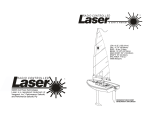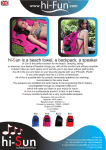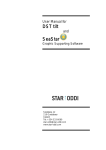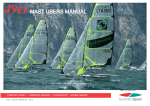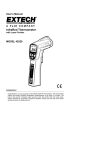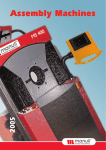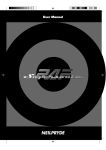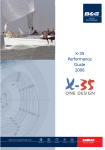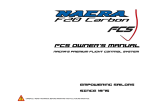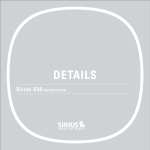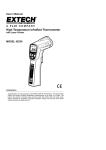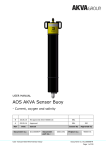Download A USER`S MANUAL
Transcript
Laser R RADIO CONTROLLED A USER’S MANUAL LOA: 41.5" (105.41cm) LWL: 37.75" (95.88cm) DSPL : 9 lbs (3.4kg) BEAM: 13.125" (33.33cm) MAIN HOIST: 52" (132.08cm) DRAFT: 16" (40.64cm) SAIL AREA: 710 sq" (4580.63sqcm) Laser RADIO CONTROLLED ©2006 Out There Technologies Laser is a registered trademark of Vanguard, Inc., Performance Sailcraft, and Performance Sailcraft, Pty R DESIGNED BY BRUCE KIRBY DEVELOPED BY JON ELMALEH warranty Limited Six-Month Warranty Out There Technologies LLC will repair or, at its option, replace any part of the RC Laser that has proven defective by reason of improper workmanship or material within six (6) months of the date of original purchase, with the following exceptions: (a) Out There Technologies will not repair or replace any part damaged as a result of collision while sailing, or misuse or abuse; (b) Out There Technologies will not repair or replace a receiver damaged as a result of immersion in water; (c) Out There Technologies will not repair or replace any part on an RC Laser which has been altered or repaired by anyone other than Out There Technologies LLC; and (d) Out There Technologies will not repair or replace the transmitter, which is subject to a separate warranty from its manufacturer. This warranty is valid in the United States of America. For warranty information outside the U.S., please consult your dealer. This warranty does not apply unless you return the enclosed registration card to Out There Technologies LLC within ten (10) days of date of purchase and provide dated proof of purchase at the time you seek repair or replacement of your RC Laser. preface Message from Bruce Kirby, Designer of the Laser It has been a great pleasure to work with world model yacht champion Jon Elmaleh in the development of this radio-controlled miniature Laser. The basic hull shape is a one-quarter scale Laser, but of course to make the boat work at the much smaller size and with no crew aboard to act as ballast, we had to develop a model yacht-type keel and rudder and slightly reduce the sail plan. I have been overjoyed at the result. The boat sails and handles exceptionally well over a broad range of wind and sea conditions and is faster than I ever expected it could be. We have kept the rig and control systems simple so that, as with any good one-design, success on the race course depends on the sailor, not the boat. And as a purely recreational sailing model it is quick to launch and easy to operate. So climb aboard with your imagination. You will find that the thrill is there, but your muscles won’t get sore and if you don’t sail in the rain you will stay dry. Rowayton, Connecticut - January, 1995 -------Message from the Manufacturer: Congratulations on your purchase. We hope the RC Laser will fulfill all your expectations. We have worked hard to make this product the best RC sailboat on the market today, and we believe the RC Laser is the one-design sailboat that sailors are looking for. OUT THERE TECHNOLOGIES, LLC www.outthere.com Please note: Out There Technologies, LLC no longer deals directly with the public. Sales and service is handled by area distributors. Please contact your local RC Laser retailer with questions and requests. -------- May the wind be with you! contents TABLE OF CONTENTS The RC Laser .......................................................................... Parts Layout ............................................................................ Assembly: Overview ............................................................................ Details: Sail and Mast ............................................................................ Keel ............................................................................ Rudder ........................................................................ Batteries ...................................................................... Rig .............................................................................. Sheet Line .................................................................... Transmitter .................................................................. Rudder Control ............................................................ Sail Control .................................................................. Radio Frequencies .................................................................... Boat Care / Radio Care / Batteries ........................................... Sail and Boat Numbers ............................................................. Decoration ................................................................................ How to Sail ................................................................................ Five Basic Rules ....................................................................... Port Tack - Starboard Tack Rule ................................... Buoy Room Rule ........................................................... Contact with Buoy Rule ................................................. Luffing Rights Rule ........................................................ Collision Rule ................................................................ Racing your RC Laser ................................................................ The Race Course ....................................................................... Model Sailing Organizations ...................................................... 1 2 3 4 5 5 6 7 7 8 8 9 10 11 12 13 14 15 15 16 17 18 19 20 20 21 1 The RC Laser was designed to be a strict “one-design” sailboat. The fundamental principle behind a one-design sailboat is that sailors may not alter their boats. This ensures that racing is a competition among sailors, not boats. If you intend to race your RC Laser, you may not change your boat in any other way other than to decorate it as explained in this manual. All replacement parts must be genuine RC Laser parts. The only exceptions are the transmitter and receiver, which may be replaced with any compatible equipment. Your RC Laser has the following components: Sail and tell tale Rudder Gooseneck Rudder servo Boom sliders (3) Antenna tube Screw eye Hull Receiver Battery holder Manual Mast Rudder bracket Rudder linkages (2) Boom Antenna mount Sheet line Sail control servo Transmitter Hatch cover Switch 2 Parts Layout SAIL TELL TALES SHEET LINE MAST GOOSENECK BOW PULLEY BOOM BOOM SLIDERS HATCH COVER POWER SWITCH KEEL LOCK SCREW EYE RUDDER BRACKET RUDDER KEEL 22 3 ASSEMBLY OVERVIEW (See following pages for detailed instructions) 1) Assemble rig by connecting mast tubes and sliding assembled mast into sail pocket. Slide boom into gooseneck. 2) Insert keel into slot at bottom of hull and slide into place, turning locking lever to secure. 3) Place rudder into hole in bottom of hull and snap rudder into bracket. 4) Place 4 AA batteries into battery holder. Place battery holder into hull and close hatch cover. Also, remove back of transmitter and install 8 AA batteries. 1 5) Slide mast into hole on deck. 6) Connect sheet line to slider by pulling loop at end of sheet line over slider tang until loop hangs from slider ring. 7) Turn transmitter on, then turn boat on by sliding switch forward. 5 6 4 7 2 3 You are now ready to sail! 21 4 1 SAIL AND MAST Lap 1 Windward buoy Offset buoy wind direction Start/finish gate START Here’s a course that offers a lot of opportunities to make choices and think about strategy, because there are a number of different paths you can take on each lap. A) Connect mast tubes. CL LS EIG OL E HC ON T T EH ER O TU Leeward gate Lap 2 and finish Windward buoy Offset buoy B) Insert assembled mast into sail pocket. FINISH CL LS EIG OL E HC ON T T EH ER O TU C) Slide boom into gooseneck. D) Thread outhaul string, attached to the sail, through the end slider and snap into the next slider forward (see page 7 for diagram) Leeward gate Sail through the starting gate, then round the windward buoy and offset windward buoy. Travel down through the leeward gate and round either buoy to the outside. Sail back towards the windward buoy and do one more lap, rounding the windward and then the offset buoy once again. After going through the leeward gate one more time, f inish by coming back through the starting gate. 5 20 RACING YOUR RC LASER There is an infinite number of possible race courses you can sail - the only limit is your imagination. Here are two of the more commonly used courses to get you started. 2 KEEL Rotate locking lever 90 degrees until lever locks in place. Modified Olympic Course wind direction Wing buoy NOTE: If the surface of the keel bulb becomes damaged, exposing the lead core, cover it with tape or paint. Keep away from exposed lead. Start/finish line 3 RUDDER Jockey for the best position during a one minute countdown. Sail two laps a ro u n d t h e c o u rs e , n o t rounding the wing buoy on the second lap. Insert rudder stud into pivot hole on bottom of hull while inserting top of rudder into rudder deck bracket. Snap rudder into bracket. Pivot hole 6 19 A leeward boat that is luffing up cannot sail past head to wind (Figure I). 4 BATTERIES wind direction Remove hatch cover. Take out battery holder. Check switch on boat to make sure it is in the off position. Install four "AA" batteries. (Alternately, you may use a pack of five NiMH rechargeable batteries. See page 11 for more information.) Replace battery holder and hatch cover. Do not put your RC Laser into the water without its hatch cover. Damage may result. Head to wind Past head to wind Figure I Your boat is sailing “head to wind” when the bow of the boat is pointed directly into the wind. If you steer your boat into the wind, past the point when it is head to wind, you have sailed “past head to wind.” If you are luffing up, you are not permitted to sail past head to wind. If you do, you lose the right of way, regardless of which tack you are sailing on. If there is a collision after the leeward boat is past head to wind, the leeward boat must do a penalty turn (see Rule 5). 5. Collision rule Whenever you collide with another boat, or fail to avoid a collision, you must sail clear of all other boats and complete penalty turns before continuing the race. Before the start of every race, the race committee or racers determine whether a penalty will consist of one or two 360 degree penalty turns. Generally, only one turn is required in light wind conditions. 18 7 4. Luffing Rights Rule 6 RIG This rule applies when you are passing another boat at close proximity. Figure F indicates the windward and leeward sides of a boat. On the starboard tack, the starboard side of the boat is the windward side. On port tack, the port side of the boat is the windward side. Windward side Slide rig (mast and sail) into mast hole on deck. wind direction Leeward side 7 SHEET LINE Figure F RULE: When two boats are sailing on the same tack (starboard tack in these examples) at close proximity (Figure G), the leeward boat has the right of way over the windward boat 2. If you are a windward boat on the offensive, you must pass with enough room to avoid the leeward boat. If you cannot avoid the leeward boat, you must steer away to avoid a collision. Connect sheet line to slider by pulling loop at end of sheet line over slider tang until loop hangs from slider ring. slider tang wind direction 1 2 slider ring Boat passing Figure G If the windward boat 2 tries to pass the leeward boat 1, the leeward boat 1 can “luff up” the windward boat 2 by steering into the wind, causing 2's sail to luff (Figure H). When a boat’s sail luffs, it loses power and speed. Luffing up is mostly as a defensive maneuver. wind direction 1 Figure H 2 8 17 3. Contact with Buoys Rule 8 TRANSMITTER The transmitter is the device that enables you to control your RC Laser from the shore. On the transmitter there are three controls: the stick on the right is the rudder stick; the switch in the center is the power switch; and the stick on the left is the sail stick. To operate the transmitter, remove back panel and install eight AA size batteries, extend the antenna and put power switch to the “on” position. After turning the transmitter on, turn the boat on by sliding its power switch forward. Do not push down, damage may result. ALWAYS turn the transmitter on before turning the boat on. A boat that makes contact with a buoy must sail away from the fleet, out of the way of other boats, and do a 360-degree penalty turn(figure E). After the penalty turn, the boat may resume racing. If the boat hits the buoy on the inside, then the turn executed as part of returning to the correct side of the buoy is accepted as the penalty turn, providing that it includes a tack and a gybe. This rule may be relaxed in RC Laser racing. Always check with your race officer. Rudder stick Do a tack and a gybe as soon as possible without interfering with other boats ON AIR HIGH NORM LOW ON POWER Figure E Contact with buoy on outside Charge crystal Trim lever Rudder Control After turning on the transmitter and the boat, move the rudder stick from side to side. The rudder will move from side to side. The rudder should be in the center position when the rudder stick is in the center position. If it is not, use the rudder trim lever to center the rudder. To steer the boat toward the right, move the rudder stick to the right; to steer the boat toward the left, move the rudder stick to the left. Figure E1 Contact with buoy on inside Round buoy in correct direction, then do a tack and gybe as fast as possible without interfering with other boats to exonerate the penalty. 9 16 Sail Control 2. Buoy room rule The buoy room rule applies when boats are rounding or passing a buoy or an obstruction on a race course. You must imagine a circle around the buoy or obstruction. The radius of the circle is four boat lengths (figure A). When your boat’s bow touches the imagined circle (figure B). imagine a line parallel to the back of your boat. If the nearest boat to your boat has not yet crossed (overlapped) the parallel line (figure C), you may round the buoy without yielding to that boat. If there is a boat that has crossed the line - an overlap (figure D) - your boat must yield to that boat. Figure A Figure C Figure B 1 Sail stick Figure D 2 No overlap 1 may round the buoy without yielding to 2 Trim lever 1 2 Inside overlap 1 must give 2 room to round buoy Your RC Laser is powered by the wind, not by your radio. However, the sail stick on your transmitter enables you to let the sail in and out to maximize your boat’s use of wind power (see “How to Sail”, p. 14). As you move the sail stick up, the wind will push the sail out. When the sail stick is all the way up, the sail will be able to move out to a position perpendicular to the center line of the boat, which is as far out as it can go. As you move the sail stick down, the sail will move toward the center line. When the sail stick is down as far as it can go, the sail will be close to the center line of the boat. Use the trim lever to fine tune the sail. You are ready to sail. Put your boat in the water and have fun! 15 10 Racing Your RC Laser Radio Frequencies The frequency of your RC Laser is indicated on the end flap of the box. Each RC Laser comes with a set of removable crystals. The crystal generates the frequency. The set is made up of one “TX” crystal for the transmitter and one “RX” crystal for the receiver. The number on the “TX” crystal, which is in the bottom right corner of your transmitter, indicates the frequency of the radio. Each boat usually uses a frequency on either the 27, 40, or 75 MHz band. If two boats attempt to sail on the same frequency at the same time within a two block range, neither boat will work properly. When you go sailing, you must find out what frequencies are available at that site. With a little cooperation, you will be able to avoid frequency conflicts. There are at least 6 crystal sets available for each frequency band. We recommend that you own at least 4 different crystal sets if you intend to sail at a number of different sites. It is quite simple to replace your crystals with another crystal set. First, turn the transmitter off and remove the “TX” crystal from the lower right corner of the transmitter. Replace it with the new “TX” crystal. Then, remove the hatch cover from the hull, pull the receiver from its mount, and pull the “RX” crystal out. Replace the crystal with the new “RX” crystal. Finally, replace the receiver and the hatch cover. You are ready to sail on your new frequency. TX RX 27 .9 95 RX Sailboat racing is a lot of fun. If you are already familiar with yacht racing rules, those rules can be used when racing the RC Laser. Even if you know nothing about sailboat racing, the following five basic rules and race course will allow you to compete on the water with experienced sailors. RC Lasers sail by the same ISAF (International Sailing Federation) rules that govern full sized sailboat racing, with the exception of Appendix E. Learn more at www.sailing.org. Five Basic Rules of Racing 1. Port tack/starboard tack rule Port refers to the left side when facing the bow of the boat. Starboard refers to the right side of the boat when facing the bow. A boat in motion is either on port tack or starboard tack. When the boom is left of the center of the boat, the boat is sailing on starboard tack. When the boom is right of the center of the boat, the boat is sailing on port tack. RULE: When sailing on a collision course, boats sailing on starboard tack have “right of way” over boats sailing on port tack. Boats on port tack must yield to boats on starboard tack. ON AIR BOW 27.995RX HIGH NORM LOW 27.995TX ON I CE RE POWER V ER STARBOARD SIDE PORTSIDE Charge crystal STERN Stick Reversing Many transmitters have reversing switches. If for some reason you wish to reverse the rudder stick direction, you can do so by changing the position on the channel 1 switch only. Do not reverse the channel 2 switch. Damage may result. PORT TACK STARBOARD TACK 11 14 How to Sail Boat Care Sailboats cannot sail directly into the wind. If a boat is pointed into the wind, the sail will luff, or flap like a flag in the breeze. Sailboats can only sail when they are at an angle to the wind. Depending on the direction you want to sail relative to wind direction, there is an angle at which the sail should be set. To sail a close-hauled course (almost directly into the wind) the sail is “in tight” i.e. at only a slight angle to the center line of the hull. On a run (sailing away from the wind), the sail should be all the way out, perpendicular to the center line of the hull. Reaching, or sailing roughly perpendicular to wind direction, has a sail position about halfway between close-hauled and a run. The RC Laser requires little maintenance. As long as you sail your boat in fresh water, you can store it immediately after removing it from the water. When storing your boat, remove all pressure from the back edge of the sail by sliding the boom sliders until they are loose. Keep your boat and radio away from excessive heat. If you sail in salt water, rinse the hull, the fittings, the mast, the boom, the keel, the rudder and the sail in fresh water after sailing and before storing your RC laser. To pull the sail in and sail a close-hauled course, move the sail stick down. To ease the sail out to reach or run, move the sail stick up. When you move the rudder stick to the right, the boat will turn to the right. When you move the rudder stick to the left, the boat will turn to the left. As a guide to trim the sail properly, no matter what course you are sailing, ease the sail out until it begins to luff. Next, pull it in until the luffing stops. Moisture is your radio’s enemy. When storing your RC Laser, leave the hatch cover open to avoid condensation, and store the transmitter in a cool dry place. Do what you can to keep your radio equipment dry! If you drop your radio in salt water, it might be salvaged if you take the batteries out and wash the radio in fresh water immediately. Use a blow dryer to dry wet equipment. Now you should be ready to put your RC Laser in the water. Good luck and good sailing! SAIL HEADING TERMS wind direction Close hauled on starboard tack Close hauled on port tack Radio Care Batteries Your RC Laser requires four 1.5 volt disposable alkaline batteries or five 1.2 volt rechargeable batteries. Alkaline batteries are good for approximately 10 hours of sailing. These can be bought at almost any store, but must be thrown out after use. Rechargeable Nickel-Metal Hydride (NiMH) batteries are the recommended choice. You’ll need a special 5-cell pack for your boat. These batteries, and chargers, are available from your RC Laser distributor and most hobby shops. For your transmitter, you will need 8 AA size alkaline batteries. Reaching on starboard tack Running on starboard tack Reaching on port tack Running on port tack Batteries, whether alkaline or rechargeable, are good for several hours depending on wind strength. If the sail control stops working, or the low light on the transmitter comes on, you must sail to the shore as quickly as possible or risk losing control of your boat. 13 12 Sail and Boat Numbers Decoration Sail numbers may or may not be included with your boat. They are primarily used for racing. Only official font and size numbers can be used. You can obtain more information about sail numbers from your local distributor. There are two ways to add color to your boat without violating the onedesign rule that boats cannot be altered: magic markers or PVC tape only. Vinyl tape sticks well to this boat material, and you are allowed to use it on both the hull and deck. Sails are easily marked using permanent markers. Sail marking make it easy to find your boat in a crowd. The only restriction is that you cannot interfere with the Laser logo, sail numbers or the manufacturer’s markings. Numbers are installed on the sail just as shown in the diagram. The last two digits are used, as shown in black, below. Leave space for a number 1. B
















